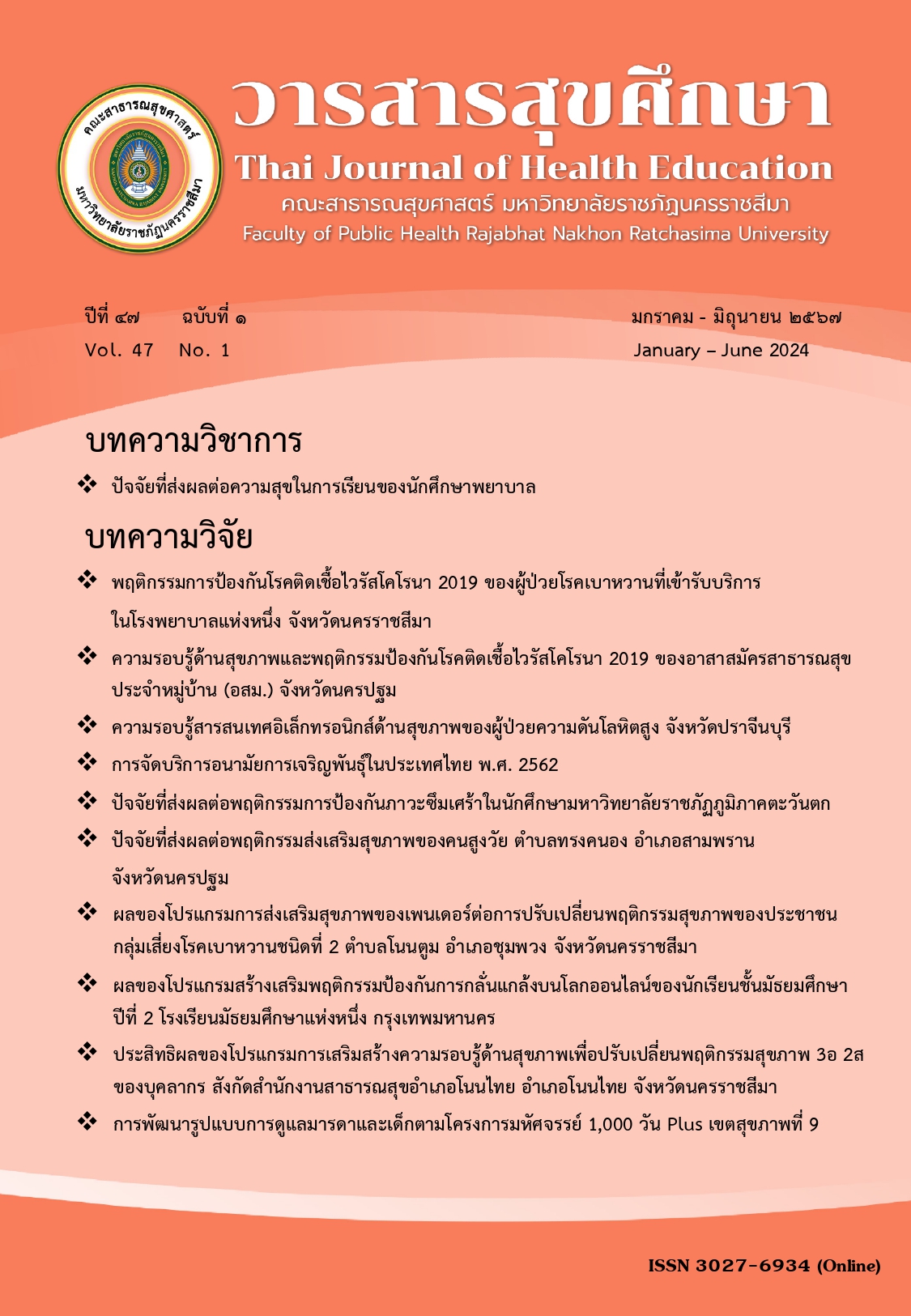Prevention Behaviors of Coronavirus Disease 2019 among Diabetic Patients Receiving Services in Hospital, Nakhon Ratchasima Province
Main Article Content
Abstract
The current situation of the COVID-19 pandemic shows that diabetic patients are at a higher risk of experiencing severe symptoms and death compared to the general patient population. Therefore, this cross-sectional analytical research aimed to study the behavior of preventing COVID-19 infection among diabetic patients receiving services in hospitals in Nakhon Ratchasima. The sample group used in the research consisted of 175 diabetic patients, selected through purposive sampling. The research tools used included a questionnaire, which comprised four parts: 1) a personal information questionnaire, 2) a test of knowledge about COVID-19 infection, 3) a questionnaire on health status perception according to a health belief model, and 4) a questionnaire on behavior to prevent COVID-19 infection. Data were analyzed using statistics, including percentages, mean, standard deviation, and Spearman’s Correlation Coefficient.The study found that: 1) Diabetic patients had a high level of knowledge about COVID-19 and perceived their health status in accordance with a health belief model at a high level, while their behavior in preventing COVID-19 infection was at a moderate level. And 2) Occupation, average monthly family income, knowledge about COVID-19, and perception of health status according to health belief model regarding the perception of severity, perceived benefits, and perceived barriers to COVID-19 infection were statistically significantly related to the behavior of preventing COVID-19 infection (p-value <0.05). However, the perception of risk did not have a relationship with the behavior of preventing COVID-19 infection.For future studies, the data obtained from this study should be used as a guideline to develop and promote behaviors that prevent COVID-19 among diabetic patients. This will lead to diabetic patients adopting sustainable healthy behaviors.
Article Details

This work is licensed under a Creative Commons Attribution-NonCommercial-NoDerivatives 4.0 International License.
References
Bhaskaran K, Bacon S, JW Evans S, J Bates C, T Rentsch C , MacKenna B . et al. Factors associated with deaths due to COVID-19 versus other causes: population-based cohort analysis of UK primary care data and linked national death registrations within the Open SAFELY platform. The Lancet Regional Health - Europe. 2021; 6:1-13.
Zhou F, Yu T, Du R, Fan G, Liu Y, Liu Z, et al. Clinical course and risk factors for mortality of adult in patients with COVID-19 in Wuhan, China: a retrospective cohort study. The Lancet. 2020; 28; 395:1054-1062.
ศูนย์ปฏิบัติการด้านนวัตกรรมการแพทย์และการวิจัยและพัฒนาศูนย์บริหารสถานการณ์โควิด-19 (ศบค.) [อินเตอร์เน็ต]. [สืบค้น วันที่ 21 สิงหาคม 2565]. แหล่งข้อมูล: https://covid19.nrct.go.th/daily-report-30sep2022/4
Katzmarzyk P, Salbaum M, Heymsfield S. Obesity, no communicable diseases, and COVID-19:A perfect storm. BMC Public Health. 2020; 32(5)2020; 32:e23484.
Nikoloski Z, Alqunaibet A, Alfawaz R, Saeed Almudarra S, Herbst C, El-Saharty, S. et al. Covid-19 and non-communicable diseases: evidence from a systematic literature review. BMC Public Health. 2021; 21:1068/10.1186/s12889-021-11116-w
Clark A, Jit M, Warren-Gash C, Guthrie B, Wang H, Mercer S. et al. Global, regional, and national estimates of the population at increased risk of severe COVID-19 due to underlying health conditions in 2020: a modeling study. Lancet Global Health. 2020; 8(8):E1003-E17.
Organization WHO. Diabetes. Fact sheets. [Internet].2020[Cited 2023 August 21]. Available from: https://www.who.int/news-room/fact-sheets/detail/diabetes.
Roncon L, Zuin M, Rigatelli G, Zulian G. Diabetic patients with COVID-19 infection are at higher risk of ICU admission and poor short-term outcome. Journal of Clinical Virology. 2020; 127 :104354
Williamson EJ, Walker, A.J., Bhaskaran K, Bacon S, Bates C, Morton C. et al. Factors associated with COVID-19-related death using Open SAFELY. 430-436.
สำนักงานสาธารณสุขจังหวัดนครราชสีมา. HDC Report กลุ่มรายงานมาตรฐาน >> การป่วยด้วยโรคไม่ติดต่อที่สำคัญ >> อัตราการป่วยด้วยโรคเบาหวาน. HDC [อินเทอร์เน็ต]. 2566 [เข้าถึงเมื่อ 2566 พฤศจิกายน 29]. เข้าถึงได้จากhttps://nma.hdc.moph.go.th/hdc/reports/report.php?&cat_id=6a1fdf282fd28180eed7d1cfe0155e11&id=cefa42b9223ec4d1969c5ce18d762bdd
สำนักงานสาธารณสุขจังหวัดนครราชสีมา ศูนย์บริหารสถานการณ์โควิด-19 (ศบค.) ทีม SAT COVID-19 HDC Report กลุ่มรายงานมาตรฐานโรคติดเชื้อไวไรโคโรนา 2019 (COVID-19 ) ข้อมูล ณ วันที่ 25 สิงหาคม 2564. [อินเทอร์เน็ต]. 2566 [เข้าถึงเมื่อ 2566 พฤศจิกายน 30]. เข้าถึงได้จากที่มา. http://odpc9.ddc.moph.go.th/hot/64-situation-covid19-25Aug.pdf
Krejcie, R. V. & Morgan, D. W. Determining Sample Size for Research Activities. Educational and Psychological Measurement. 1970;30(3), pp. 607-610
Bloom BS. Learning for mastery. UCLA-CSEIP Evaluation Comment. Los Angeles: University of California; 1968.
Best JW. Research in education. New Jersey: Prentice Hall; 1997
ประภัสสร เรืองฤๅหาร วรินท์มาศ เกษทองมา และวุธิพงศ์ ภักดีกุล. พฤติกรรมการป้องกันโรคติดเชื้อไวรัสโคโรนา 2019 (COVID-19) ของผู้สูงอายุที่ป่วยเป็นโรคเบาหวานในจังหวัดสกลนคร. วารสารวิจัยและพัฒนาระบบสุขภาพ. 2565;15(12)254-268.
พนัชญา ขันติจิตร และคณะ. แบบแผนความเชื่อด้านสุขภาพในการป้องกันโรคติดเชื้อไวรัสโคโรนา 2019 (COVID-19) ของประชาชน ในจังหวัดอุบลราชธานี.วารสารวิทยาศาสตร์สุขภาพ วิทยาลัยพยาบาลบรมราชชนนีสรรพสิทธิประสงค์. 2564;5(2):39-53.
Chow, N., Fleming-Dutra, K., Gierke, R., Hall, A., Hughes, M., Pilishvili, T., Ussery, E. Preliminary Estimates of the Prevalence of Selected Underlying Health Conditions Among Patients with Coronavirus Disease 2019 — United States, February 12–March 28, 2020. MMWR. Morbidity and Mortality Weekly Report. 69(13): 382–386.
ณัฎฐวรรณ คําแสน. ความรู้ ทัศนคติ และพฤติกรรมในการป้องกันตนเองจากการติดเชื้อไวรัสโควิด-19 ของประชาชนในเขตอำเภออู่ทอง จังหวัดสุพรรณบุรี. วารสารวิทยาลัยพยาบาลพระจอมเกล้า จังหวัดเพชรบุรี. 2564;4(1): 33-48.
Poonaklom P, Rungram V, Abthaisong P, Piralam B. Factors Associated with Preventive Behaviors towards Coronavirus Disease (COVID-19) among Adults in Kalasin Province, Thailand. Outbreak, Surveillance, Investigation & Response (OSIR) Journal. 2020;13(3): 78-89
กชกร สมมัง. ปัจจัยที่มีความสัมพันธ์ต่อพฤติกรรมการป้องกันโรคไข้หวัดใหญ่ของผู้รับบริการงานผู้ป่วยนอกโรงพยาบาลพระนารายณ์มหาราช. วารสารสุขศึกษา. 2557;37(126): 8-21
Becker MH, Maiman LA. The health Belief Model: Origins and Correlation in Psychological Theory. Health Education Monography. 1975;2: 336-85.
สุภาภรณ์ ชูเชิดรัตนา, จารุเนตร ศรีคำสุข, ชญาณ์นันท์ ผาคำ, ธัญวรัตนม์ เทพอุดม, ปิยมน พวงคำ พันทิภา หมื่นโกฏิดี และคนอื่นๆ. ความสัมพันธ์ระหว่างความเชื่อด้านสุขภาพกับพฤติกรรมการป้องกันโรคโควิด–19 ของพนักงานรักษาความปลอดภัย มหาวิทยาลัยนเรศวร. วารสารการพยาบาลและสุขภาพ. 2564;15(2): 78-89.
Stretcher V. J., & Rosenstock, I. M. The heath belief model. In K. Glanz, F. M. Lewis, &B. K. Rimer, (eds.), Health behavior and health education: Theory, research, and proactive. San Francisco: Jossey-Bass. ;1997.31-43.16
Wong LP, Alias H, Wong PF, Lee HY, Abu Bakar S. The use of the health belief model to assess predictors of intent to receive the COVID-19 vaccine and willingness to pay. Human vaccines & immunotherapeutic. 2553;16: 204-14.
เยาวลักษณ์ ชาวบ้านโพธิ์. บทบาทของอาสาสมัครสาธารณสุขประจำหมู่บ้านในการป้องกันการระบาดโรคติดเชื้อไวรัสโคโรนาสายพันธุ์ใหม่ 2019 อำเภอพระประแดง จังหวัดสมุทรปราการ. วารสารรัฐประศาสนศาสตร์ มหาวิทยาลัยราชภัฏสวนสุนันทา. 2564;4: 44-58.


